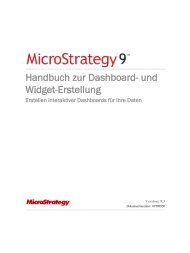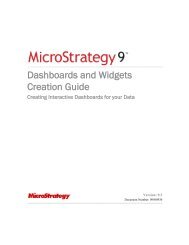Report Services Document Analysis Guide - MicroStrategy
Report Services Document Analysis Guide - MicroStrategy
Report Services Document Analysis Guide - MicroStrategy
Create successful ePaper yourself
Turn your PDF publications into a flip-book with our unique Google optimized e-Paper software.
3<br />
Analyzing <strong>Document</strong>s in <strong>MicroStrategy</strong> Web <strong>Report</strong> <strong>Services</strong> <strong>Document</strong> <strong>Analysis</strong> <strong>Guide</strong><br />
• The individual rectangles under each heading represent single attributes.<br />
In this example, they represent different mutual funds, such as<br />
Oppenheimer Main Street A (in the top right) and Vanguard Small Cap<br />
Index (by the tooltip).<br />
• The size of each rectangle represents its relative weight. This widget<br />
shows that Large Blend funds are weighted more heavily than Mid-Cap<br />
Blend funds in regard to net assets.<br />
• The colors displayed in the widget represent different ranges of return<br />
year-to-date percentages generated by the mutual funds. In the image<br />
above, blue denotes higher percentages, while red and purple denote<br />
lower percentages. You can define the colors used to denote these values,<br />
as described in Interacting with a Heat Map widget in Flash Mode and<br />
Interactive Mode, page 101.<br />
• When you hover your cursor over a rectangle, data about that rectangle is<br />
displayed in a tooltip. This includes the data described in the bullet points<br />
above, as well as additional information that does not affect the Heat Map<br />
widget. In this example, the Vanguard Small Cap Index data is displayed.<br />
To<br />
successfully analyze Heat Map widgets with large datasets, Flash<br />
Player 10 or later must be installed on your computer.<br />
Some Heat Map widgets are combined with an interactive selector so you can<br />
select a different attribute element to view on the Heat Map widget. For<br />
example, a Heat Map widget displays Revenue values for categories and<br />
subcategories. The selector allows you to choose which regions to display<br />
category and subcategory for.<br />
Executing a report or another document from a Heat Map<br />
widget<br />
A Heat Map widget can have links, which allow you to connect from the<br />
widget (the source) to another document or a report (the target).<br />
Information can be passed from the source to the target. For example, the<br />
target can display information only for the object selected in the source, for<br />
the objects chosen in the source’s prompt, or for specific, pre-determined<br />
objects, among other options. If the widget has links, when you hover your<br />
cursor over an attribute element in the widget, the Links menu is displayed.<br />
You can click a link in the Links menu, and the target opens.<br />
For example, the Region attribute in the Heat Map widget shown below is<br />
linked to the Top 2 Employees by Call Center report. This report is prompted<br />
for Region, and the link passes the current region to the report. In Flash<br />
100 Flash analysis and interactivity: widgets © 2012 <strong>MicroStrategy</strong>, Inc.












![The New Era of Mobile Intelligence: [PDF] - MicroStrategy](https://img.yumpu.com/13859921/1/190x245/the-new-era-of-mobile-intelligence-pdf-microstrategy.jpg?quality=85)
![customer success story [pdf] - MicroStrategy](https://img.yumpu.com/13859884/1/190x146/customer-success-story-pdf-microstrategy.jpg?quality=85)
![Call for Speakers Guide [PDF] - MicroStrategy](https://img.yumpu.com/13859856/1/190x245/call-for-speakers-guide-pdf-microstrategy.jpg?quality=85)

